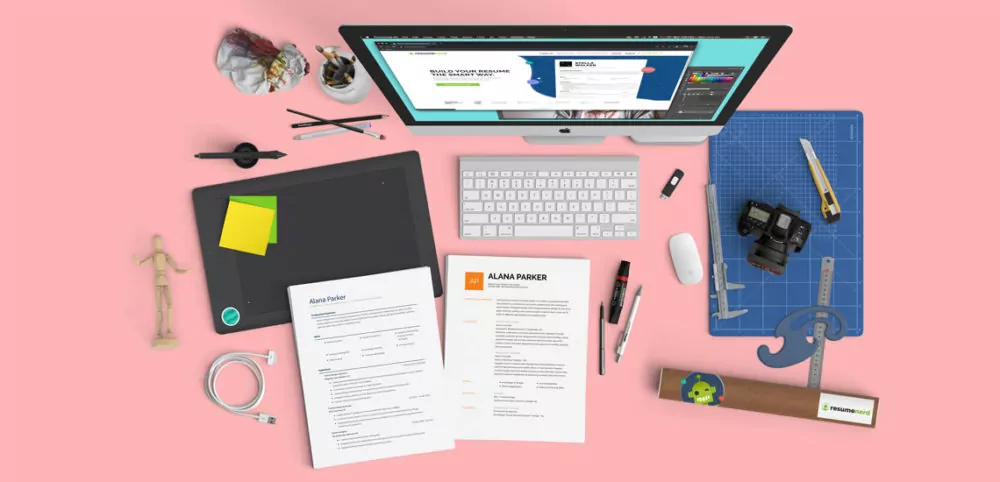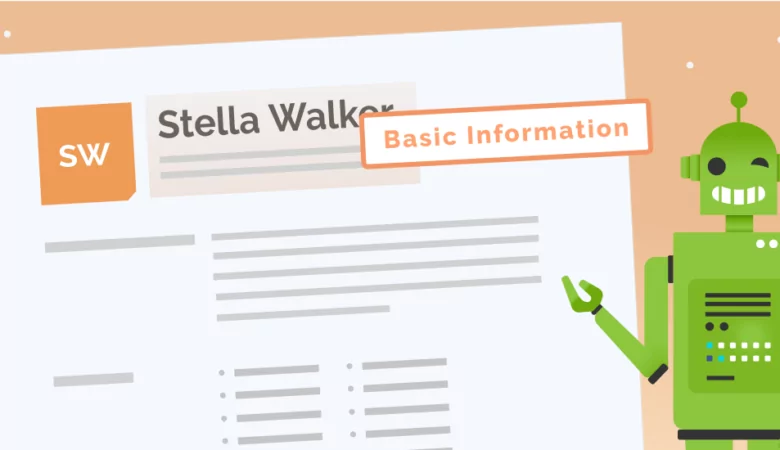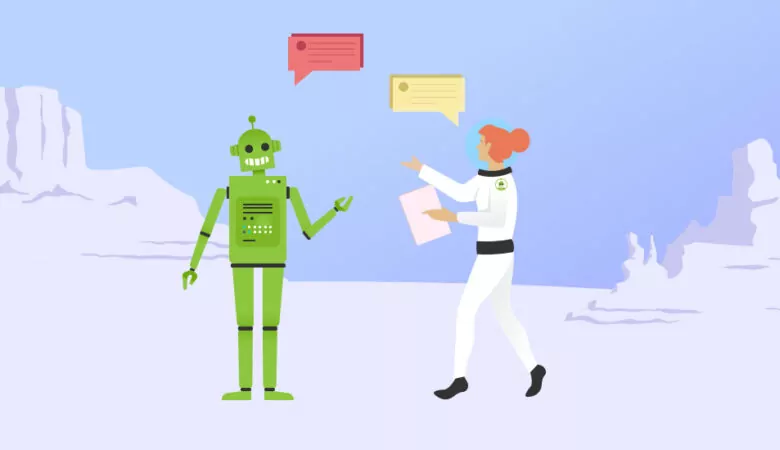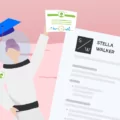Ready to take the first step toward a creatively fueled career? In this guide, we’ll offer tips for the best resume formats for creatives and how to make your passion into your livelihood.
Table of Contents
- – Introduction
- – Traditional Formats for Creative Resumes
- – Get Creative Without Messing Up Your Resume
- – How to Format Work Experience on Creative Resumes
- – How to Highlight Creative Projects, Side Gigs, and More
- – How to Use Supplemental Materials with Your Resume
- – The Final Word on Creative Resumes
 Introduction
Introduction
When it comes to creativity, the all-too-common saying is “don’t quit your day job.” But why not take a different approach and make your day job creative?
Creative jobs can be found in a variety of fields. However, creative fields are unique in that they tend to be arts-based rather than corporate in nature. Think: companies involved in design, fine arts, or performing arts. Within that framework, employment in a creative field can cover a wide array of professions ranging from visual arts to acting to music performance and writing.
There are plenty of creative job positions out there. To separate yourself in what can be very competitive fields, you need a professional resume that shows your responsibility in addition to your creativity.
In this guide, we’ll explain how to create the best resume format for creatives and provide tips on showing your creativity within the bounds of a traditional resume format.
 Traditional Formats for Creative Resumes
Traditional Formats for Creative Resumes
Creativity and frivolity should not be synonymous when it comes to your resume. Sure, you may have decided to take the road less traveled with your career. However, it’s vital to stick to a standard resume format to show you have the professional chops to get the job done.
Remember: your resume will typically go to a hiring professional first. An untraditional or avant-garde format may not be well received. Further, your resume is likely to be sent through an ATS (applicant tracking system) before the hiring human even sees it. An ATS is automated software, and can only scan and understand resumes which contain expected language and show up in a traditional resume format.
We’ll talk about how to demonstrate your creativity on your resume; first, get the basics right in an easily recognizable format.
What Are the Three Main Resume Formats?
What is a traditional resume? There are three main resume formats: chronological, functional, and combination resume format.
Here’s a quick explanation of each one:
Chronological Resume Format
This is the most traditional resume format out of the bunch. It focuses mainly on work experience, which takes up the majority of the document. The experience is listed in reverse chronological order, beginning with the most recent position and ending with the oldest.
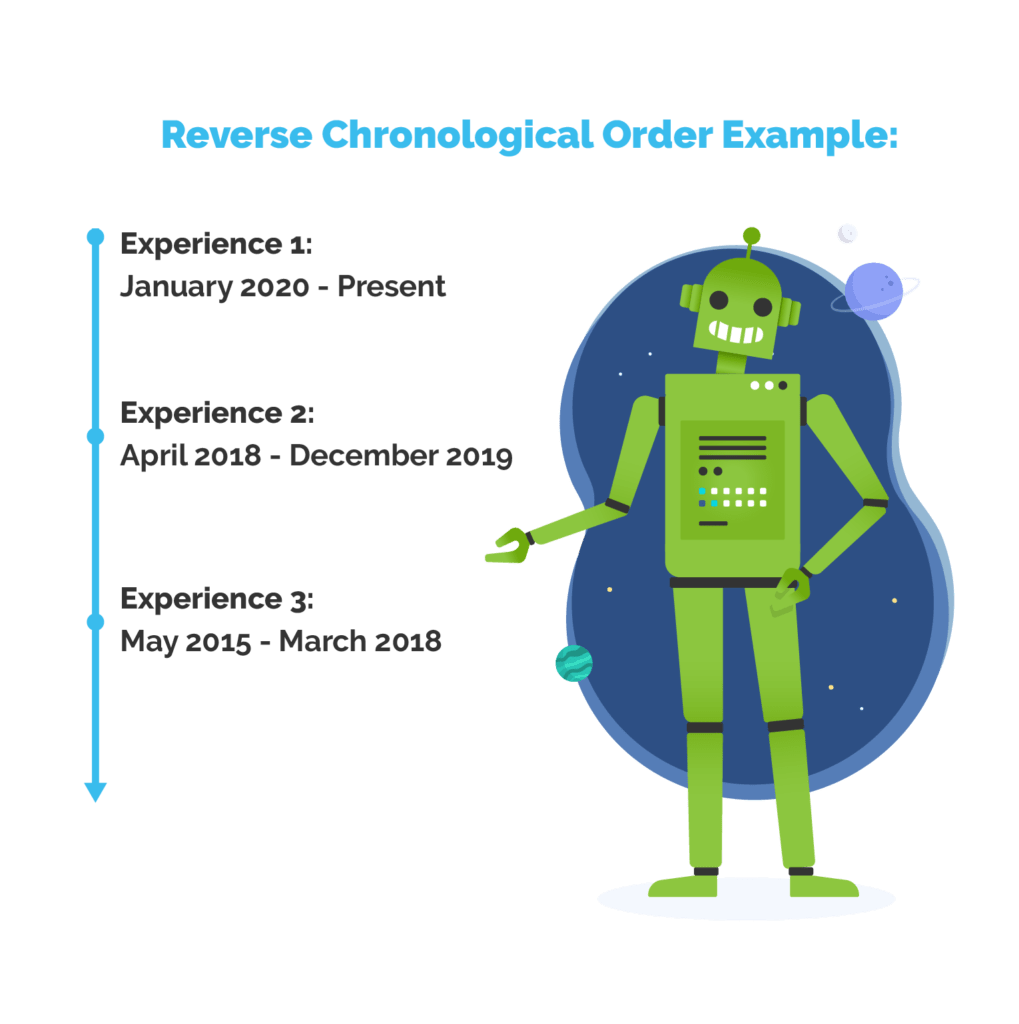
Skills, education, and other sections all get second billing. The reverse chronological resume is the best choice in the majority of job-seeking situations. If in doubt, pick this format.
Functional Resume Format
Less common than the chronological resume format, the functional resume format is useful for career changes or for those who have little or no work experience. It focuses on skills that pertain to the job being offered.
Work experience may be mentioned, but it comes second to job skills. Hiring managers often distrust a functional resume format, however, as it is often used to hide employment gaps and lack of experience. If a functional resume format seems like a good choice, we recommend reverting to the combination resume format instead.

Combination Resume Format
The combination resume format falls somewhere between the chronological and functional resume formats. It puts relatively equal emphasis on skills and work experience, usually listing skills first. This format is also common for career changes, but by adding work experience you can show a potential employer that you’re capable of finding success in a position, even if it isn’t in the same field.
What About a CV?
Good question. In the creative field, sometimes a CV (short for curriculum vitae) is also requested by potential employers. So…what type of resume is that? Actually, none of the above.

While a CV is also used for job applications, it is not actually a resume. There are two important differences between a CV and a resume : the length and overall purpose.
A resume is competency-based, which means it’s more like a factual sales sheet where you bullet point your work experience, skills, education, and achievements. The CV, on the other hand, is credential-based. It’s favored for fields like academia and medical professions. However, it’s also sometimes appropriate in the creative sphere.
For example, if you’re a fine art painter, a CV might be the most effective way to offer a comprehensive overview of your career, including a chronology of gallery shows, group shows, and fellowships. If you’ve been busy, you’ve got more space to spread out, too: a CV is also often longer than a typical resume, and can span several pages.
One resume format (or choosing a CV) isn’t necessarily better or worse for creatives–it’s all about the job being offered and your level of experience.
For example, academic positions usually require a CV, where more traditional jobs–even in creative fields–will usually require a resume.
Geography also plays into it. As a creative, you may be applying for positions or contracts overseas. In many non-US countries, a CV is the standard job application document. This goes for all fields, creative or traditional. So be sure to do your research on whether the hiring company expects to see a resume or CV before you apply!
Resist the temptation to think that sticking with a traditional resume format seems boring. You can find ways to showcase your creativity while still sticking to the formatting rules for resume templates. The next section will explain this in greater detail.
Traditional Resume Formats for Creatives: Review
- Even if you are pursuing creative positions, you need to prove to an employer that you’re a professional. To do that, it’s best to stick with traditional resume formats.
- There are three main types of resumes: chronological, functional, and combination resume format. There isn’t one that is better or worse for creatives; rather, it will depend on the job being offered and your level of experience.
- For some creatives, such as fine artists, a CV may also be a good choice for job applications.
 How to Get Creative Without Messing Up Your Resume
How to Get Creative Without Messing Up Your Resume
Think about art in a gallery. The art itself may be very creative and free form, but the way it’s displayed is precise and measured. That’s intentional. The display is designed to showcase the art, to focus attention on the quality of the art itself. If it were hung sloppily, it wouldn’t have as great an impact and wouldn’t seem as valuable.
Your resume serves a similar purpose: it’s an organized document that helps you best demonstrate your value. It provides a necessary structure to showcase your creativity. While the resume itself may not be as free-form as you like, it can move you toward your creative goals by demonstrating your skills and professionalism.
That said, there are some ways to add a little flair to your resume.
Showing Creativity on Your Resume: Dos and Don’ts
| ✓ Cover Letter “Do’s” Review | |
|---|---|
|
✓ Choose a resume template with personality. For example? A minimalistic, futuristic, sleek, or colorful format. However, within that format, follow all of the general formatting rules.
✓ Demonstrate your professionalism. Even though you’re creative, you mean business. Prove so to the hiring manager with a complete, detailed, perfectly formatted resume.
✓ Let your experience speak for itself. If you’ve completed impressive creative projects, they will speak for themselves. Point hiring professionals in the direction of any appropriate imagery or examples, but don’t put these elements on the resume itself.
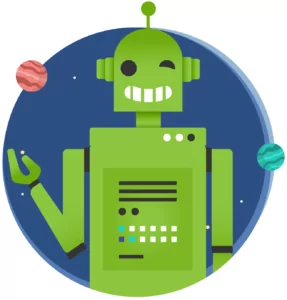 |
|
| X Cover Letter “Don’ts” Review | |
|---|---|
|
X Don’t make it hard to read. Say no to a patterned background, calligraphic elements, hand-drawn features, or extra-special paper. These will only make your resume confusing and hard to read. Stick with a standard format.
X Don’t use imagery or include your creative work directly on the resume. Supplemental materials, or a portfolio, can help take care of that. We’ll cover that in a succeeding section.
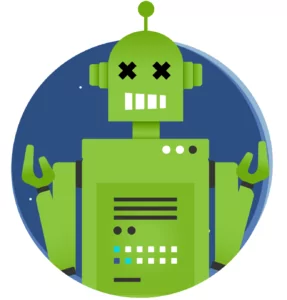 |
|
 How to Format Work Experience on Creative Resumes
How to Format Work Experience on Creative Resumes
For a creative, your work experience should be a curated showing of your relevant achievements and work. Think carefully about which of your creative projects to include and how to highlight them in a way that’s relevant to your targeted creative job.
First, view your creative work experiences as jobs. Then list them following a traditional work experience section format.
Formatting creative projects as work experience is important, because it demonstrates that you can hold your own professionally. You show that you have successfully executed and completed projects in the past, that you can work with others, are able to assume responsibility, and are ready for the role being offered.
What to Include in the Experience Section on a Creative Resume
What kind of experience do you have that could translate well to a creative field?
Here are some examples:
Creative positions in traditional fields. Even if you’ve worked in traditional fields in the past, if your positions have made use of your creativity and skills, they could translate well to the job you’re applying for.
Perhaps you’re a writer who held a 9-5 job as a content writer for a publication, or you are a musician who worked in a music studio in addition to doing side gigs. By listing these jobs, you’ll be able to show your potential employer that you have both creativity and a great work ethic.
Creative freelance or contract jobs. If you held an ongoing position in a creative field, even if it was short term or part time, it’s worth listing on your resume. However, one-off assignments should not be listed under your work experience section (more later on how to include them on your resume).
In general, you’ll want to include an overview about who you worked for, what kind of role you held, and how you achieved goals.
Here’s exactly what you’ll want to include in the experience section:
✓ Company or organization name:
Include the full name of the company or organization you worked for.
✓ Location:
Include both the city and state, but the precise street address is not necessary.
✓ Your title or role:
What was your job title? For example, it might be “Set Painter” For a theatrical production, or “Content Writer” for a freelance blogging job.
✓ Dates of employment:
Include the month and year you started and finished the project. The exact calendar dates usually aren’t necessary.
✓ Responsibilities and achievements:
Show your stuff! List 2-4 short bullet points about what you did and what you achieved. Be sure to work carefully so that you highlight skills or achievements that will help you succeed at the job you’re applying for now.
Let’s put it to work with an example. Say that you’re applying for a content writer position and want to list some freelance writing you’ve done in the experience section of your resume. Here’s how you might list it:
| ✓ Freelance Writing Experience Example |
|---|
|
Content Writer
|
Or if you are applying for a job as a graphic designer, a listing might look like this:
| ✓ Freelance Graphic Designer Experience Example |
|---|
|
Infographic Designer The Dapper Dog, Inc., Philadelphia, PA September 2018-November 2018
|
As with any resume, be sure to carefully read through the job listing for the position you’re applying for. Whenever possible, include specific words or phrases from the listing to show that you have specific experience that applies well to the current job you’re applying for. Not only will this practice help your resume get pass an ATS and onto the hiring manager’s desk, it will also show that you’ve paid careful attention to the job and how you can bring value to the organization.
How to Format Work Experience on Resume for Creatives: Review
✓ When formatting the work experience section on a creative resume, follow the chronological resume format’s organization of the work experience section.
✓ List creative positions as you would any other job; include the company or organization name, location, dates worked, your responsibilities, and any notable achievements.
✓ Include specific words or phrases from the job listing for the job you’re currently applying for. It will help demonstrate that your past experience has prepared you well for the job being offered.
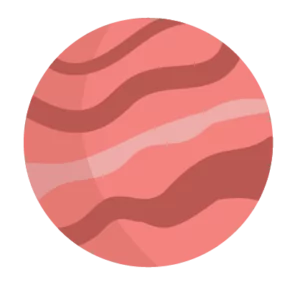 How to Highlight Creative Projects, Side Gigs, and More
How to Highlight Creative Projects, Side Gigs, and More
Few creative career paths follow a traditional trajectory. They’re often a cobbled-together variety of one-off assignments, short term side gigs, and/or freelance projects.
If you’ve been pursuing a creative career, chances are you have plenty of odds and ends experience-wise. These might contribute to your overall prowess in your field, but they might not warrant individual listings in your experience section.
Since these experiences have value, you want to include them on your resume. But what’s the best way to do it? And how can you share your side gigs or freelance projects without making a hiring professional wonder if you’ll be distracted once you get the job you’re applying for?
Below, you’ll find strategies and tips for effectively showcasing your side gigs and projects on a traditional resume.
Organizing Side Gigs or Freelance Projects on Your Resume
One way to effectively condense short term or one-off projects–and make them appropriate for your work experience section–is to list similar ones under one general heading. Instead of having one listing for each company that you provided freelance writing for, group them under one listing and highlight one or two things that stand out about each position. For example, if you’re a freelance writer, your listing might look like this:
| ✓ Freelance Writing Experience Example |
|---|
|
Freelance Writer, 2015-2019 Various Locations August 2017-November 2018 Provided content writing, ghostwriting, and copywriting for a variety of clients, including: The Fried Chicken Blog
TenderMuffin.org
Unicorn Central
|
By organizing freelance projects by theme like this, your resume is clearly organized and shows a potential employer that you have valuable experience in a specific sector or field. It shows the results of your targeted creative efforts.
What to Emphasize With Freelance Projects or Side Gigs
As with any resume, you want to use any experience–be it a job or a side gig–to make a case for yourself as the best candidate for the job being offered. Here are some tips for what to focus on:
✓ Relevant experience:
While you may have worked on a super cool art installation at Burning Man, if you’re applying for a photography assistant position, it might not be the most appropriate experience to list on your resume.
✓ Specific keywords from the listing:
Take advantage of any experience you list as a new opportunity to demonstrate that you possess skills and experience that match what the potential employer is looking for. When possible and appropriate, use keywords or similar phrasing to what is written in the job listing.
✓ Show your skills:
If one of your projects required specific skills that may make you seem more appetizing to a potential employer, name them! In particular, hard skills that relate to the position at hand should be noted.
 How to Use Supplemental Materials with Your Resume
How to Use Supplemental Materials with Your Resume
One of the biggest challenges when crafting a creative resume is figuring out how to sell yourself without offering physical examples of your creative work on the document itself.
However, there are ways to share specific examples of your work by adding supplemental materials to your resume.
What Is Supplemental Material?
Here are some examples of supplemental materials:
- An online portfolio featuring visual artwork, links to writing, etc.
- A link to an expanded CV or online resume with live links to completed creative works.
- Social media, blogs, or LinkedIn pages
- A link to a more creative version of your resume that shows your skills and personality
- A video or reel
How to Include Supplemental Materials
on a Resume?

The most effective way to include supplemental materials will depend on the job listing in question.
Often, with creative job listings, an employer will specifically ask for a certain number of files or links to examples of your work. If so, adhere to their guidelines. However, these materials will always be sent in addition to your resume, and should never be included directly on the resume.
If there are no guidelines for submitting supplemental materials, there are a few ways that you can include them. One way, of course, is to include a separate file along with your resume and your cover letter. However, if doing this, be sure not to bog down someone’s inbox with a ton of attachments or huge files—that’s just annoying. Create a neat collection of relevant media and compress it as a zip file before sending. Or use a cloud-based, secure file-sharing service and include a link to the collection.
Another option is to include a link to a website or a page containing examples of your work on your resume. This is a nice approach, because it’s clean, organized, and lets hiring professionals share the link with any other decision makers.
As for where to link? One of the best spots is right at the top of your resume, under your contact information. So, for instance, your basic information section might look like this:
| ✓ Freelance Basic Information Example |
|---|
|
Jane Yeast 123 Bread Street Bakerytown, PA 19111 P: (555) 555-5555 |
Be sure to mention any supplemental materials in your cover letter as well, to point hiring professionals in the direction of any additional images or materials you’d like them to see and how they can find them.
 The Final Word on Creative Resumes
The Final Word on Creative Resumes
Even if you want to pursue a highly creative career, you still need to follow a traditional resume format. After all, you aren’t just demonstrating your talent to a potential employer, but your professionalism and ability to get the job done, too.
Your resume provides necessary structure to your career and helps you present yourself to employers in the best light. Showcasing your experience and achievements in a well organized and properly formatted resume can help you land the creative job offer of your dreams…and those results can be pretty glamorous and cool, even if your resume is traditional!
